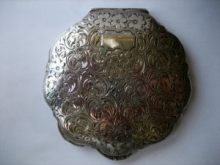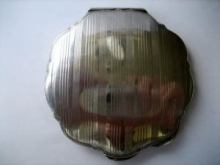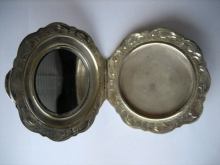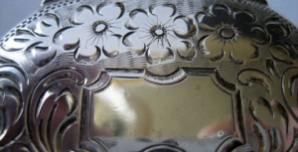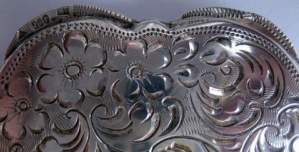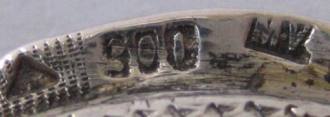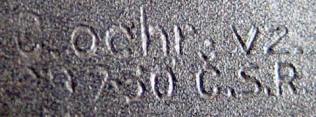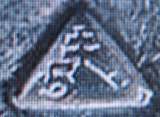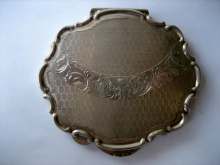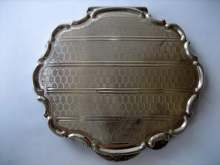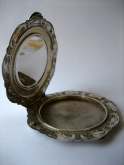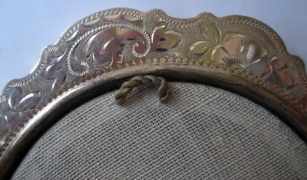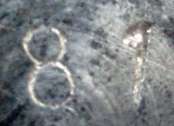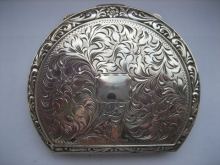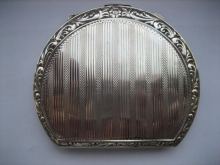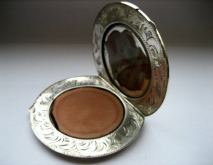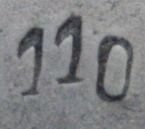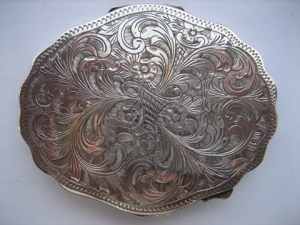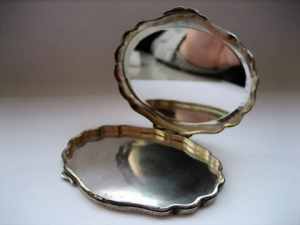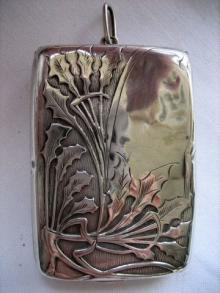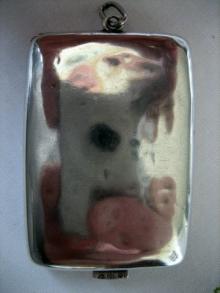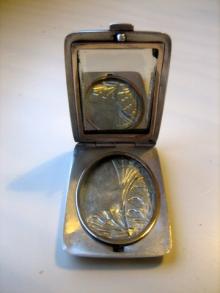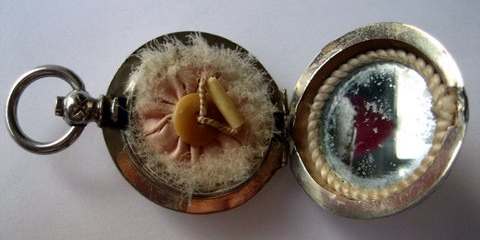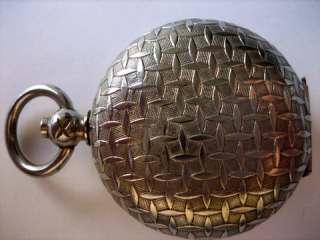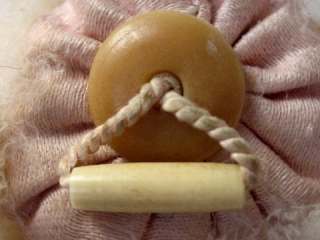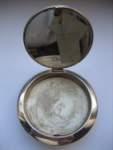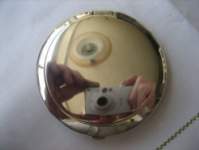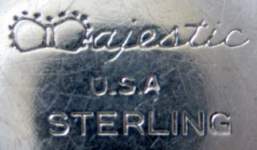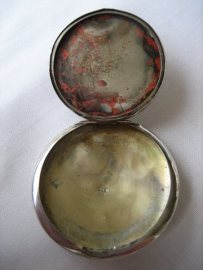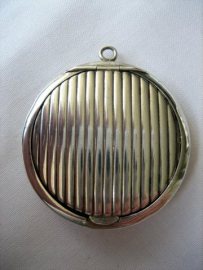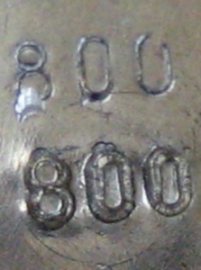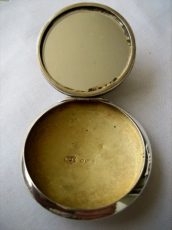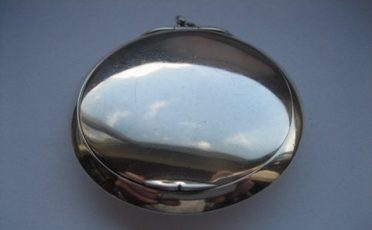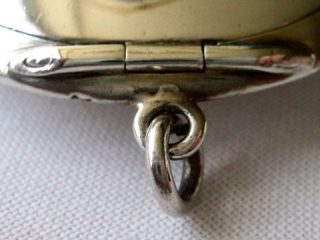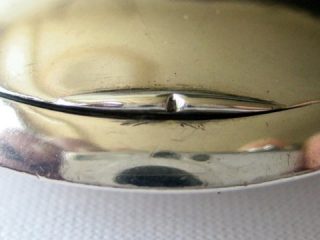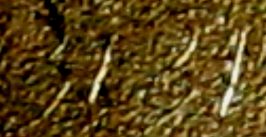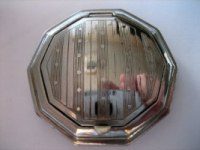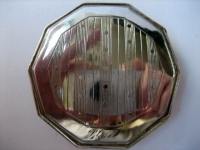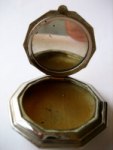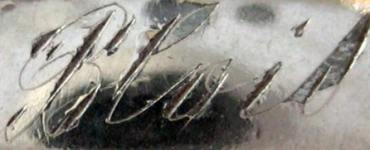by Robert
Massart
(click on photos to enlarge image)
POWDERING WITH STYLE
Silver Powder Puff Boxes of the 20th Century
Since centuries women use make-up to make themselves more
attractive to please men. During the Art Nouveau and Art Deco
periods it was not different and the powder puff box was part of
the vanity accessories of a lady’s make-up.
The powder puff boxes we will discuss in this article, all
belong to the style periods of Art Nouveau and Art Deco. They
were manufactured in different countries but show the same
stylish characteristics of subject art periods.
Before describing the pocket-sized articles also named
power-case flapjack puff boxes, in detail, a good definition is
required.
- The powder puff box is an item of a lady’s toiletry,
consisting of different parts:
- the main body - in this case made of silver or silvered -
- an integrated net inserted in the bottom of the powder puff
box under which the make-up powder is stored,
- a powder puff and a mirror encased in the upper lid.
One of the sides of the lid is hinged and sometimes (for small
boxes) surmounted by a ring for suspension.
The powder puff is a soft pad for applying powder to the skin.
Czechoslovakia 1929/1942
Art Nouveau solid silver flapjack powder puff box. The front
flap is extremely decorated with flowers and scrolls and a
vacant cartouche. The interior as well is richly chiselled with
flower motifs and scrolls. The mirror inside is in fine
condition.
The powder puff and net are missing. The back of the powder puff
box is decorated with parallel lines.
The marks are clearly struck to the rim and the inner bottom.
Marks on rim: "900" for silver fineness, a triangle
referring to the period c.1929-1942 and M.V in a rectangle for
maker's mark.
Marks inside box: C. ochr. VZ. over 29730 C.S.R. (Czecho-Slovakian
Republic) and 900 200 M.V
Diameter 82 mm and thickness 13 mm. Weight: 91 grams.
Czechoslovakia 1929/1942
Crafted in thick gauge solid silver this hinged powder puff
box is an excellent example of Art Nouveau style. The lid is
decorated with a fine network and a garland of flowers and
leaves. The rim of the oval powder puff box is adorned with
joined scrolls.
The reverse side of the powder puff box is decorated with a fine
lattice work separated by horizontal lines.
The inside rim is chiselled with scrolls, flowers and leaves.
The mirror and the original filter are in good condition.
The lid bears the hallmarks 900 for silver fineness, a
triangle indicating the period c.1929-1942 and a rosette for the
maker's mark.
Figure 81 is punched in the interior bottom.
Dimensions: 86 mm x 80 mm x 11 mm.
Weight: 109 grams.
Czechoslovakia 1929/1942
Art Nouveau style solid silver, heavily decorated, flapjack
powder puff box.
The powder puff box is in the shape of a three-quarter moon and
the interior as well as the front flap are chiselled with flower
and leave motifs.
The back flap has ornaments of parallel lines and the rim has
also a decoration of flowers and leaves.
The original filter is present and in good condition. The mirror
has lost most of his mercury-layer.
The rim clasp lock bears following marks:
900 for silver fineness, a triangle indicating the period c.1929-1942
and the maker’s mark Mb.
The figure 110 is punched in the interior bottom.
Dimensions: 100 mm x 87 mm x 11 mm.
Weight: 124 grams.
Italy after 1936 (possibly)
Oval Art Nouveau solid silver powder puff box. The oval mirror is in perfect condition. Both flaps are identically decorated
with a basket, palmleaves and flowers, and have a nicely gadrooned rim. The rim clasp lock works perfectly.
The upper flap is marked inside with ITAL (Y ?), a figure in a (possibly) lozenge which is not legible anymore, and 800 for the silver fineness.
The lower flap is marked inside with 32, an oval with 2 letters (vaguely legible) and N in a circle.
Dimensions: 80mm x 65 mm x 8 mm. Weight: 52 gram.
The powder puff box was bought in an Antique shop in Antwerp, Belgium
Germany after 1888 (Make-up Box)
In fact this silver box does not meet the definition of a
silver powder puff box. However, it remains a vanity box because
it is equipped with a mirror. However, seen its beauty I wanted
to include it in this article.
It is a solid silver make-up box in typical Art Nouveau style.
The front lid is nicely decorated with leaves and the back flap
is plain.
The interior front panel has an oval picture holder surrounded
by a gilded frame with glass and the interior bottom side is
fitted with a rectangular mirror surrounded by a gilded frame.
The required German hallmarks since the Federal Act of 16th
July, 1884 (active from January 1888) are punched in the clasp
lock:
- crown and crescent moon
- Silver fineness : .800
- maker’s mark registered at the Reichspatentamt: an oval with a
figure vaguely legible (leaves ?).
Dimensions: 54 mm x 38 mm x 10 mm.
Weight: 39 grams
France (possibly)
Beautifully decorated, small powder puff box in the shape of
a pocket watch with its original matching puff and a mirror
surrounded by a silk string.
The powder puff box can be opened with a push button system
located on top of the box. The lid is surmounted by a movable
ring for suspension.
Both flaps are adorned with a lattice work.
There are no hallmarks or maker’s mark present.
The powder puff box has a diameter of 35 mm and is 16,5 mm thick.
The powder puff box was bought in an antique shop in Versailles,
France.
U.S.A.
Elegant, round Art Deco solid silver powder puff box with
plain front and bottom panels, manufactured in the United States
of America by Majestic Mfg. Co., New York. The firm was active
since the 19th century and was incorporated in 1895.
The mirror (1 mm thick) is broken and glued inside the upper lid.
The powder puff and net are missing.
Marked on outer bottom with ‘U.S.A. STERLING’ and ‘Majestic’
Diameter 74 mm and 13 mm thick. Weight: 51 grams
Belgium (possibly)
Solid silver round powder puff box, Art Deco period, with a
gilded interior bottom and a round mirror in the interior front
panel.
The lid of the powder puff box is decorated with parallel
grooves and ridges (fluting) and is surmounted by a small ring
for suspension.
The silver fineness mark 800 is punched twice in the
interior bottom side. No Maker’s mark.
The powder puff box has a diameter of 42 mm and a thickness of 8
mm.
Weight: 14 grams
Bought in an antique shop in Antwerp, Belgium
India - Calcutta
Art Deco, small round solid silver powder puff box with
plain front and bottom panels.
The front panel is fitted with a mirror at the interior and the
bottom side is gilded and punched with three hallmarks and a
maker’s mark.
The powder puff box is surmounted by two connected rings for
suspension.
Hallmarked with silver fineness .925, a flower with leaves
in an oval and a date letter ‘N’ in a square for the year 1949
(1).
Maker’s mark: H & Co (o inserted in the C) in a three leaves
clover, standing for Hamilton & Co of Calcutta (2).
The engraved number 3131 in the gilded bottom is hardly legible.
Dimensions: diameter 45 mm and thickness 11,5 mm. Weight: 20
grams.
(1) The British regulation on hallmarks was not in force in
the British colonies, therefore immigrated silversmiths marked
the silverware with their trademark and own pseudo hallmarks
closely similar to those in use in the homeland.
(2) Robert Hamilton (1772-1848) arrived in India and started
work in Calcutta. He opened his Jewellery and Silversmithing
shop at 5 Tank Square in 1808 under licence of the East Indian
Company. In 1811 the business moved to 7 Court House Street,
where it remained until 1973 when it finally closed. Hamilton &
Co is probably the best known and celebrated British silversmith
operating in India. His silver works are always elegant with
minimal decoration (mainly plain design).
For more information concerning Hamilton & Co see
Giovanni Ciceri # 59 article in ASCAS website.
France (possibly)
Ten-sided silvered powder puff box with front and backside
decorated with parallel lines and dots. The powder puff box is
gilded inside.
The back flap is engraved with the name ‘Blois’ (3).
There are no hallmarks or maker’s mark present.
Dimensions: 47 mm wide and 12 mm high. Weight: 22 grams.
Bought in an antique shop in Versailles, France.
(3) Blois is a French town located at a strategic point
between two hills at the right bank of the river Loire. However,
the inscription could also be the name of the original owner.
Conclusion
Though both international art styles climaxed in popularity
during the years 1892 until 1902 for Art Nouveau (4) and
during the interbellum for Art Deco (5), their influence
was still obvious until the Second World War.
Colonial countries such as India even continued to produce
artifacts in Art Deco style well into the 1960s.
The silver powder puff boxes portrayed earlier in the article
clearly illustrate the craftmanship of the silversmiths of these
artistic periods.
(4) Art Nouveau was an international style of art, architecture and
design. The movement was a reaction to the fading shapes of
impressionism. Common characteristics of this style are
undulating, flowing lines often in the shape of stylised plants.
Other names for the style are Jugendstil (German speaking
countries of Europe and Nordic countries), Secession (Austria),
Münchener Sezession (Germany), Modern Style (England), Modernism
(Spain) and Stile Liberty (Italy). Whereas the style developed
in France and Brussels, Art Nouveau was also extremely present
in the earlier Austro-Hungarian countries such as Czechoslovakia.
Many Art Nouveau buildings in Prague are still a marvel to the
tourists’eyes.
(5) Art Deco was a design movement, lasting from 1920 until
1939. It was purely decorative, using zigzagged, geometrical and
jumbled shapes.
The art works were focused on elegance and practicality.
|
|
 ASSOCIATION OF SMALL COLLECTORS OF ANTIQUE SILVER
ASSOCIATION OF SMALL COLLECTORS OF ANTIQUE SILVER